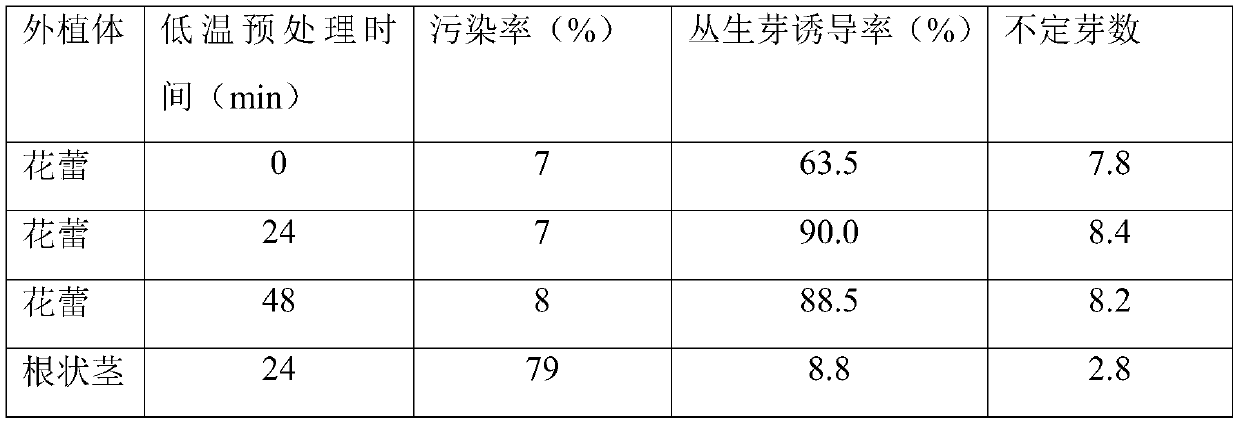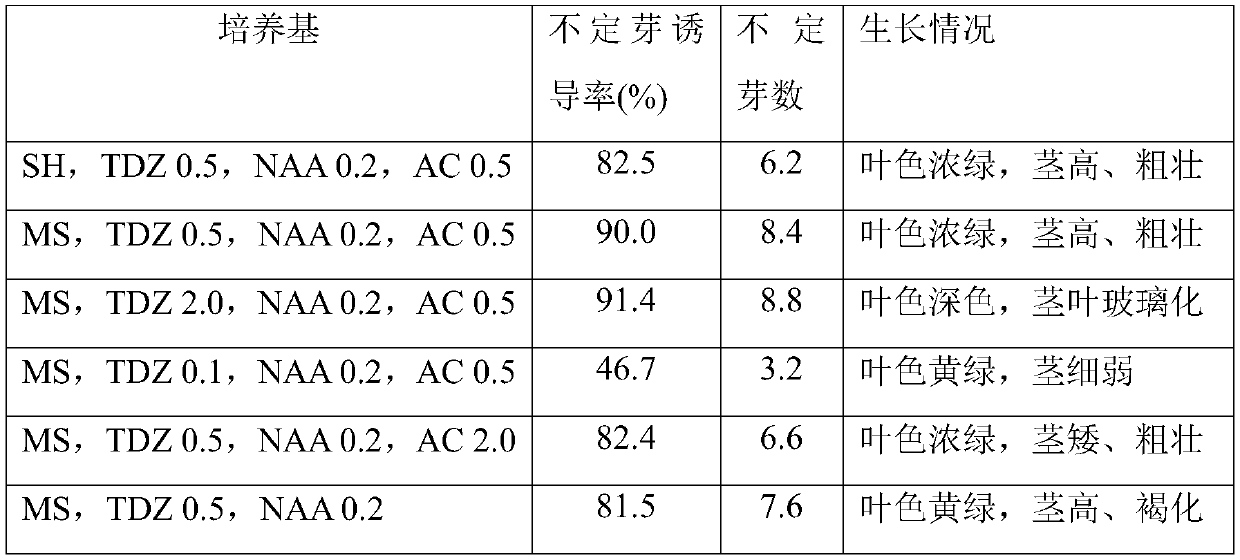A method for tissue culture and rapid propagation of Polygonatum longiflorum
A tissue culture, Polygonatum chinensis technology, applied in horticultural methods, botanical equipment and methods, plant regeneration, etc., to achieve the effects of reducing pretreatment time, low pollution rate, and beneficial to industrial production
- Summary
- Abstract
- Description
- Claims
- Application Information
AI Technical Summary
Problems solved by technology
Method used
Image
Examples
Embodiment 1
[0029] A method for tissue culture and rapid propagation of Rhizoma Polygonatum, comprising the following steps in turn:
[0030] (1) Disinfection of Polygonatum long-stemmed flower buds
[0031] In May of that year, take the flower buds of Polygonatum long-stemmed that have not yet bloomed, put them in the refrigerator at 4°C for 12-24 hours, add an appropriate amount of detergent solution to soak for 2 minutes, wash them with running water for 0.5-1.0 hours, and put them in the ultra-clean bench Turn the stem section into 70% alcohol solution and soak for 1min, rinse it with sterile water for 3 times, and dip it in 5 drops of Tween-80, the mass fraction is 0.1% HgCl 2 The solution is soaked and disinfected for 9-10 minutes, and then fully soaked with sterile water for 3 times to obtain the sterilized explant material, and the success rate of disinfection can reach more than 90%.
[0032] (2) Induction of clustered buds
[0033] Put the explant material obtained in the prev...
Embodiment 2
[0041] The difference between this example and Example 1 lies in step (1): Disinfection of Polygonatum long-stemmed flower buds: In May of that year, take the flower buds of Polygonatum long-stemmed that have not yet bloomed, put them in the refrigerator at 4°C for 0-48h, take them out and add them Soak in an appropriate amount of detergent solution for 2 minutes, rinse with running water for 0.5-1.0 hours, then transfer the stem segment to 70% alcohol solution and soak for 1 minute in an ultra-clean bench, rinse with sterile water for 3 times, immerse in 5 drops of Drip Tween-80, HgCl with a mass fraction of 0.1% 2 The solution is soaked and disinfected for 9-10 minutes, and then fully soaked with sterile water for 3 times to obtain the sterilized explant material. It can be seen from the statistical results 30 days after inoculation that the pollution rate obtained by using flower buds as explants for disinfection is far lower than that of using rhizomes as explants, and the...
Embodiment 3
[0045] The difference between this embodiment and Example 1 is that step (2): the induction of clustered buds: put the explant material obtained in the previous step on sterile filter paper, cut off the head and tail, remove the stamens and pistils, and cut the petals into 2cm 2 Size, in the MS basic medium with TDZ 0-2.0mg / L, NAA 0-1.0mg / L, AC 0-2.0g / L, the amount of sucrose in the medium is 30g / L, agar The amount is 8.0g / L, the pH is 5.8-6.0, and the medium has been sterilized at 121°C for 20min, the same below. The petal-connected culture medium was first cultured in the dark for 0-7 days, and the culture temperature was 28±2°C; then it was transferred to light culture, and the culture conditions were as follows: the culture temperature was (28±2)°C, and the light time was 14h light / 10h dark, light intensity 30-40μmol / (m 2 s); after 30d, statistics found that; the different treatments of TDZ concentration showed that low concentration TDZ (0.1mg / L) had lower adventitious...
PUM
 Login to View More
Login to View More Abstract
Description
Claims
Application Information
 Login to View More
Login to View More - R&D
- Intellectual Property
- Life Sciences
- Materials
- Tech Scout
- Unparalleled Data Quality
- Higher Quality Content
- 60% Fewer Hallucinations
Browse by: Latest US Patents, China's latest patents, Technical Efficacy Thesaurus, Application Domain, Technology Topic, Popular Technical Reports.
© 2025 PatSnap. All rights reserved.Legal|Privacy policy|Modern Slavery Act Transparency Statement|Sitemap|About US| Contact US: help@patsnap.com



